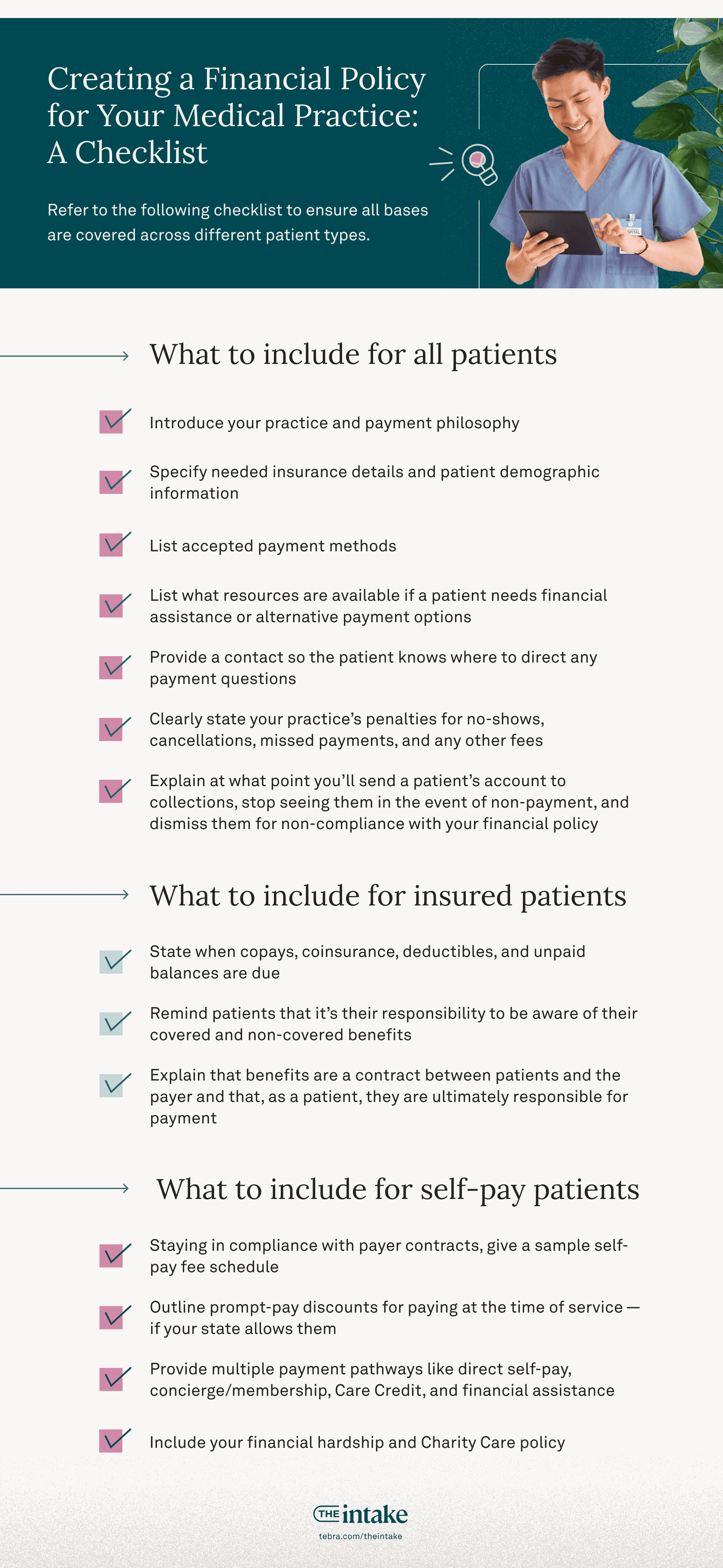Overview
- A clear financial policy reduces billing disputes and improves collections.
- Transparent pricing and payment plans enhance patient trust.
- Enforcing policies consistently ensures financial stability.
If collecting patient payments seems to have gotten harder for you as an independent practice owner in recent years, you’re not alone. Improving the patient collection process in today’s medical landscape starts with asking: what are the basic elements of an effective medical office financial policy?
No longer something to sign and file away, your financial policy is now one of the most important documents to have in a practice. As the document upon which communicating patient financial responsibility hinges, all staff members need to understand and refer to it, including physicians.
Read on for a sample financial policy checklist for your medical practice. Then, we’ll dive into why a modern healthcare practice needs to create and share an effective financial policy with patients in order to provide quality care and thrive financially.
Download your free resource now
Access it instantly — just complete the form

What should a practice's financial policy tell patients?
A good financial policy makes clear, in writing, the responsibilities of both the practice and the patient. It should outline exactly what you expect from your patients, leaving no room for misunderstanding on either side.
“An effective financial policy outlines exactly what you expect from your patients, leaving no room for misunderstanding on either side.”
When drafting your financial policy, refer to the following checklist to ensure you're covering all bases across different patient types:
What to include for all patients:
- Introduce your practice and your payment philosophy: practice pricing transparency. Explain that you’re partnering to serve patients through their healthcare and financial experience.
- Specify which insurance details and patient demographic information you need.
- List your accepted payment methods. Do you accept cash, check, credit cards, credit cards on file, healthcare gift cards, digital vs. in-person?
- List what resources are available if a patient needs financial assistance or alternative payment options.
- Provide a contact (staff name, phone, and email) so the patient knows where to direct any payment questions.
- Clearly state your practice’s penalties for no-shows, cancellations, missed payments, and any other fees.
- Explain at what point you’ll send a patient’s account to collections or stop seeing them in the event of non-payment.
- Explain at what point you’ll dismiss them from your practice for non-compliance with your financial policy.
What to include for insured patients:
- State when copays, coinsurance, deductibles, and unpaid balances are due.
- Remind patients that it’s their responsibility to be aware of their covered and non-covered benefits.
- Explain that benefits are a contract between patients and the payer and that, as a patient, they are ultimately responsible for payment.
What to include for self-pay patients:
- Staying in compliance with payer contracts, give a sample self-pay fee schedule. This is typically 10%-25% higher than your lowest contracted rate.
- Outline prompt-pay discounts for paying at the time of service, typically around 10%.
- Provide multiple payment pathways like direct self-pay, concierge/membership, Care Credit, and financial assistance.
- Include your financial hardship and Charity Care policy.

Why is it important for a medical practice to share its financial policy with patients?
In today’s medical landscape, there are numerous reasons why patients are having an increasingly difficult time paying their healthcare bills. Employers are shifting healthcare costs to their employees. More Americans are choosing high-deductible plans — 53.6% of private sector workers in 2022, according to a new study. And for those put on furlough or faced with job loss during the pandemic, paying healthcare bills dropped even further down the list.
“Not only does sharing a financial policy help independent practices gain more control over their finances, but it’s also essential in maintaining positive patient relationships.”
The benefits of a strong financial policy can’t be understated. Not only does sharing a financial policy help independent practices gain more control over their finances and reverse the cycle of revenue decline, but it’s also essential in maintaining positive patient relationships. When you’re firm about presenting financial options, it’s easier for patients to make informed decisions based on their financial state.
Healthcare practices with clear and firm financial policies:
- Are more likely to receive payment at the time of service, which is a huge benefit to cash flow.
- Reduce the time they spend on collections and pursuing past-due accounts.
- Minimize possible confusion between patients and providers, strengthening the doctor-patient relationship.
Download your free resource now
Access it instantly — just complete the form

Equipping your practice with modern financial tools
Creating and sharing a good financial policy isn’t something to be taken lightly. To keep your practice financially strong, make quality care possible, and help patients avoid financial pitfalls, a firm financial policy needs to be treated as an invaluable part of your independent practice.
The right tools will make your practice’s financial tasks significantly easier. It’s important to regularly ask:
- Whether your practice management software is working for you.
- Whether you have an easy, reliable communication system with your patients.
Modern technology from Tebra lets independent practice owners collect faster, at higher rates, and with less effort. By automating, speeding up, and improving accuracy in many aspects of your patient collection process, you can put your focus back on your main priority: serving patients and ensuring high patient outcomes.
Discover how Tebra’s billing and payment software can help your practice thrive today.
Download your free resource now
Access it instantly — just complete the form

You might also be interested in
Crack the code for beating medical billing challenges with this free workbook — which provides tips around improving patient collections, streamlining claims submissions, and reducing rejections and denials.






